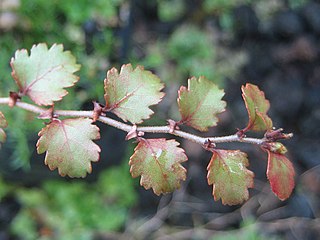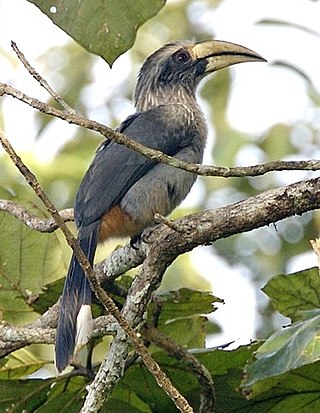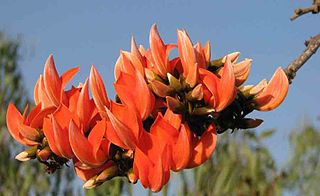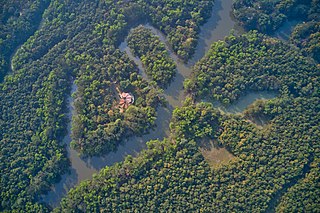
The Indomalayan realm is one of the eight biogeographic realms. It extends across most of South and Southeast Asia and into the southern parts of East Asia.

Sir Joseph Dalton Hooker was a British botanist and explorer in the 19th century. He was a founder of geographical botany and Charles Darwin's closest friend. For 20 years he served as director of the Royal Botanical Gardens, Kew, succeeding his father, William Jackson Hooker, and was awarded the highest honours of British science.

Antarctic flora are a distinct community of vascular plants which evolved millions of years ago on the supercontinent of Gondwana. Presently, species of Antarctica flora reside on several now separated areas of the Southern Hemisphere, including southern South America, southernmost Africa, New Zealand, Australia, and New Caledonia. Joseph Dalton Hooker was the first to notice similarities in the flora and speculated that Antarctica had served as either a source or a transitional point, and that land masses now separated might formerly have been adjacent.

The Malabar gray hornbill is a hornbill endemic to the Western Ghats and associated hills of southern India. They have a large beak but lack the casque that is prominent in some other hornbill species. They are found mainly in dense forest and around rubber, arecanut or coffee plantations. They move around in pairs or small groups, feeding on figs and other forest fruits. Their loud cackling and laughing call makes them familiar to people living in the region.

The Malabar Coast moist forests are a tropical moist broadleaf forest ecoregion of southwestern India.

Butea is a genus of flowering plants belonging to the pea family, Fabaceae. It includes five species native to the Indian Subcontinent, Indochina, Tibet, and southern China. It is sometimes considered to have only two species, B. monosperma and B. superba, or is expanded to include four or five.

Valmiki National Park is a tiger reserve in the West Champaran District of Bihar, India. It is the only national park in Bihar. Valmiki Tiger Reserve covers 898.45 km2 (346.89 sq mi), which is 17.4% of the total geographical area of the district. As of 2022, there were 54 tigers in the Reserve.
Rajaji National Park is an Indian national park and tiger reserve in the Indian state of Uttarakhand. that encompasses the Shivaliks, near the foothills of the Himalayas. It covers 820 km2 (320 sq mi) and includes three districts of Uttarakhand: Haridwar, Dehradun and Pauri Garhwal. In 1983, three wildlife sanctuaries in the area namely, Chilla, Motichur and Rajaji were merged into one.

The flora of India is one of the richest in the world due to the wide range of climate, topology and habitat in the country. There are estimated to be over 18,000 species of flowering plants in India, which constitute some 6-7 percent of the total plant species in the world. India is home to more than 50,000 species of plants, including a variety of endemics. The use of plants as a source of medicines has been an integral part of life in India from the earliest times. There are more than 3000 Indian plant species officially documented as possessing into eight main floristic regions : Western Himalayas, Eastern Himalayas, Assam, Indus plain, Ganges plain, the Deccan, Malabar and the Andaman Islands.

The Lower Gangetic Plains moist deciduous forests is a tropical and subtropical moist broadleaf forests ecoregion of Bangladesh and India. The ecoregion covers an area of 254,100 square kilometres (98,100 sq mi), comprising most of Bangladesh and the Indian states of West Bengal, Bihar and Tripura, and extending into adjacent states of Odisha, Uttar Pradesh and a tiny part of Assam, as well as adjacent western Myanmar.

Nagzira Wildlife Sanctuary is Situated in Tirora, Arjuni (Sadak) & Goregaon Tahsils of Gondia District and Sakoli, Bhandara, Lakhni Tahsil of Bhandara district. The closest National Highway is NH-53. Nagzira Wildlife Sanctuary is locked in the arms of nature and adorned with a picturesque landscape, luxuriant vegetation and serves as a living outdoor museum to explore and appreciate nature. This sanctuary has a number of fish, 34 species of mammals, 166 species of birds, 36 species of reptiles and four species of amphibians. The invertebrate fauna includes a number of butterfly and other insect species. Large wild mammals present here include the Bengal tiger, Indian leopard, gaur, sambar, nilgai, chital, wild boar, sloth bear, Indian muntjac, Indian spotted chevrotain and dhole. There is also an Indian elephant named Rupa. Nearly 30,000 tourists visit this sanctuary annually.

Flora of Australia is a 59 volume series describing the vascular plants, bryophytes and lichens present in Australia and its external territories. The series is published by the Australian Biological Resources Study who estimate that the series when complete will describe over 20 000 plant species. It was orchestrated by Alison McCusker.

Terminalia chebula, commonly known as black- or chebulic myrobalan, is a species of Terminalia, native to South Asia from Pakistan, India and Nepal east to southwest China (Yunnan), and south to Sri Lanka, Malaysia, and Vietnam.

The state of Karnataka in South India has a rich diversity of flora and fauna. It has a recorded forest area of 38,720 km2 which constitutes 22% of the geographical area of the state. These forests support 25% of the elephant population and 20% of the tiger population of India. Many regions of Karnataka are still unexplored and new species of flora and fauna are still found. The mountains of the Western Ghats in the western region of Karnataka are a biodiversity hotspot. Two sub-clusters of the Western Ghats, Talacauvery and Kudremukh, are on a tentative list of sites that could be designated as World Heritage Sites by UNESCO. The Bandipur and Nagarahole national parks which fall outside these subclusters were included in the Nilgiri biosphere reserve in 1986, a UNESCO designation. In the Biligiriranga Hills the Eastern Ghats meet the Western Ghats. The state bird and state animal of Karnataka are Indian roller and the Indian elephant. The state tree and state flower are sandalwood and lotus. Karnataka is home to 524 tigers.

Andhra Pradesh Forest Department is one of the administrative divisions of Government of Andhra Pradesh. It is headed by the Principal Chief Conservator of Forests, Head of Forest Force. The primary function of this department is protection, conservation and management of forests in the Andhra Pradesh State. The Forest Department is organized into 12 territorial circles and 43 divisions. In addition, one Senior Officer of the rank of Deputy Conservator of Forests functions as Planning and Extension Officer in each district.
Bihar is a state in East India. It is bounded by Uttar Pradesh to the west, Nepal to the north, West Bengal to the east and Jharkhand to the south. About 7% of the state is protected forest area.
Bhimbandh Wildlife Sanctuary is a wildlife sanctuary in Bihar in the south-west of Munger District.
Papikonda National Park is a national park in India, located near Rajamahendravaram in the Papi Hills of the Alluri Sitharama Raju and Eluru districts of Andhra Pradesh, and covering an area of 1,012.86 km2 (391.07 sq mi). It is an Important Bird and Biodiversity Area and home to some endangered species of flora and fauna. No part of Papikonda remains outside East and West Godavari districts after 2014 and the construction of Polavaram Dam.
Telangana has special climatic conditions due to its unique location in the heart of the Deccan Plateau. It is considered suitable for the developing flora and fauna. There are famous wildlife sanctuaries all over the region.The state of Telangana harbors a total of 2,800 taxa belonging to 1,051 genera under 185 families with its diverse ecosystems and varied agro-climatic regions, is home to a rich and vibrant flora. The state's flora encompasses a wide range of plant species, including both native and cultivated varieties.Telangana tropical rainy type of climate prevails, The State has a wide variety of soils and they form into three broad categories - red, black and laterite with Tropical moist deciduous forests, Southern dry deciduous forests, Northern mixed dry deciduous forests.
















